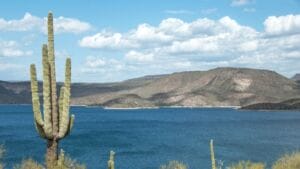Monitors observing Lake Powell’s water levels are issuing a dire warning: The second largest reservoir in the country, and one of the most popular destinations for Arizonans and Western tourists, will suffer yet another year of drought and accelerated decline. Hydrologists say this is the consequence of a lack of winter 2024 runoff, itself the product of an unseasonably dry cold season.
Experts predict the winter melt, which is responsible for replenishing the endangered lake, will total just 55% of the annual average. The average was calculated by comparing the runoff amounts observed between 1991 and 2020.
The initial forecast was more optimistic last December, calling for a runoff measuring 92% of the average. But as mid-winter precipitation failed to form in earnest along the Rockies, that figure fell rapidly, decreasing to 81% in January, then 67% by February.
The current 55%-of-average forecast represents 3.5 million acre-feet of water making its way into the lake as temperatures climb and melt what few packs formed. The lake currently holds just over 7.5 million acre-feet of water. This figure represents less than one third of the reservoir’s capacity, which is closer to 24.3 million acre-feet.
Although the forecast for runoff has decreased to a figure measuring less than the 2023 and 2024 runoffs, it’s a better prognosis than the worst year. In 2021, the melt’s replenishment reached a record low of just 1.85 million acre-feet.
As the lake continues to shrink, surrounding states disagree on how to reduce their 40 million residents’ collective water use to stave off the reservoir’s total destruction. Arizona, California, Colorado, Nevada, New Mexico, Utah and Wyoming legislators are sparing over which locales should decrease their residential, commercial, and agricultural intakes.
At the same time, Arizona is experiencing an unprecedented statewide drought, putting pressure on authorities to siphon more from the Colorado River Basin to address the state’s water needs. The U.S. Drought Monitor places most counties in the D3 (Extreme) and D4 (Exceptional) categories for drought conditions; just one locale—the northeastern corner of Apache county—is rated at D0 (Abnormally Dry).
The current Drought Severity & Coverage Index, or DSCI, which totals drought conditions across Arizona, put the state at a near record of 348 on May 27th. Just one year ago, the figure stood at 95.
As the lake’s longstanding ramps and shore access shrink, access for boats and recreators has become a challenge. Authorities last September explained the Dangling Rope Marina, once a popular launch to wakeboard and water ski the reservoir’s nearby snaking passages, would close; declining water levels made its use unsustainable. Utah is considering expanding vehicular access around the perimeter of the reservoir to at least partly address access concerns.
Despite conflicting talks between states about how to reduce water use to save the reservoir, hydrologists and researchers agree: Lake Powell will not recover on its own. Before 2025, the Colorado River Basin—the primary collector and transporter of runoff for the lake—experienced record snowpack formation, with 2023 totaling 166% of the 30-year average.
Despite this, the melt from that season only replenished the lake to 38% of its capacity in July, up from a level of 22% in February. In 2024, snowpack totals reached 113% of the average, creating a runoff measuring 83% of the average, which added roughly 5.3 million acre-feet of water to the reservoir. But these consecutive records only brought water levels up to 42% of capacity by July 2024.
The increasing difference between snowpack and runoff totals is from years of drought sapping the region’s soil, which now absorbs more runoff than before, leaving less water to replenish the lake.
Because of continued extreme weather and increasingly common drought conditions throughout the basin, these discrepancies are likely to grow, with a 27% difference between snowpack melt and runoff totals expected in 2025.
Year-round increases in average temperature and droughts have also contributed to a nearly 20% reduction in the Colorado River’s flows, exacerbating the conditions that prevent snowpack melt from replenishing the lake.
While states continue arguing about who should reduce their water use and by how much, the deadline for writing the new guidelines approaches, which existing rules expiring in 2026. With agriculture accounting for more than half of all water consumed from the Colorado River, states will have to invest in new and more sustainable irrigation methods to maintain crops and livestock, in addition to making growing communities less dependent on the basin’s waters—lest Lake Powell finally run dry.




